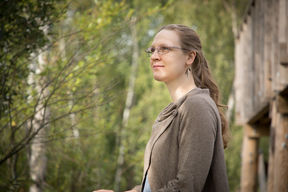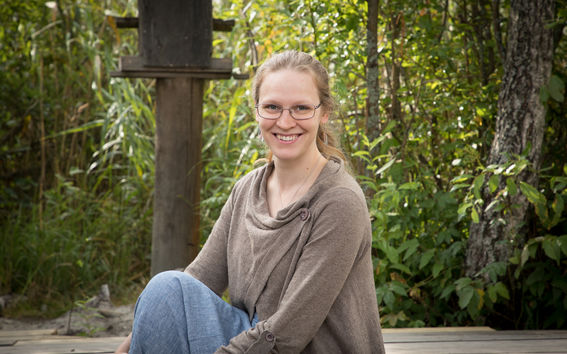When physician and AI work together, the patient benefits

Artificial Intelligence opens up new avenues into for example health care, but its potential is as of now not fully put to use. There are many reasons, but the most important one became clear to Iiris Sundin as she was starting her doctoral studies on machine learning: machine and Man must learn to work together.
"When I acquainted myself with the research of my advisor, Professor Samuel Kaski, on user modeling where the machine tries to understand the human, I realized the huge potential. Cooperation can mean other things than the human operating Excel or passively staring at projections on the screen," says Sundin, a doctoral student at the Department of Computer Science at Aalto University.
Sundin's research combines Medicine and technology and many other interests of hers. She has also always wanted to work at something that benefits other people. On the other hand, she was interested in mathematics and programming.
The role of AI and machine learning in health care is researched a lot. Sundin's point of view is unique in having the machine make use of the doctor's knowledge to define the best possible care for the patient.
There are uncertainties in the world that must factor in when decisions are taken
Physicians have vast quantities of knowledge that is never written down and that is impossible to feed directly into a learning algorithm. Sundin and her colleagues have found out just how the machine could make use of such knowledge in, for example, figuring out the efficacy of a given type of medication.
Sundin and her colleagues have at their disposal, for instance, data on gene specimens collected from cancerous cells, courtesy of FIMM, Institute for Molecular Medicine Finland. Researchers took a look at the mutations in the specimens and tried to predict which cancer medicine would work best for each patient.
It is crucial to remember that there are always uncertainties in the world, and thus, also a physician's knowledge of the effect of different mutations can be uncertain. The machine learning model devised by the research group takes this into account. The results show including expert knowledge in machine learning models and emphasizing data improve prognoses on how a given patient will react to a particular treatment.
Iiris SundinI realized that researching was such great fun that I rather do more of the same
So the model developed by researchers depicts realistically how sure people are of the different properties of real matters. 'I would that such thinking were more common: we don't just discuss the average person, we acknowledge there are differences, and take it into account when reaching decisions. That way, things can be modeled in a more useful manner.'
The researcher gets to tell something new about the world
Even though Sundin was fond of mathematics already as a child, and it comes naturally to her to see the world via mathematical thinking, art held a big role in her life, especially when she was young.
As a schoolgirl, she played the piano, sang in a choir, read books and attended art school. Now, she is into yoga, air acrobatics and camping. A researcher can be interested in many things, and creativity, for example, helps at work, too. "When you e.g. make posters for a conference, it is very useful if you can do some of the visual elements yourself."
The antics of engineering students were something Sundin grew up with. Both her parents graduated from the Helsinki University of Technology, and the family always celebrated First of May with parents’ college pals. All the adults sported the traditional tassel caps of engineering students. So engineering studies came naturally. "The degree of an engineer is really well-rounded and offers a good start. You can choose to be a researcher, industrial work or pretty much anything."
Sundin completed her Master’s in Automation and System Technology. Although she never fancied herself a researcher, her interest in it was kindled when she was working on her dissertation. Sundin was modeling the properties of a drop of fluid on different surfaces.
Research offered a way to bring received mathematical ways of thinking and skills into the real world, and to tell something about that world. "I realized it was such great fun that I rather do more of the same."
"You succeed at work if you are open"
Sundin says she sometimes imagined researchers worked alone in their chambers. That is no longer the case, anyway. "You succeed better at work is you are open, socially adept and like to travel to conferences and network with the people there."
It is crucial for a doctoral student to possess the wish and motivation to understand things. The point of further studies is to delve into one fairly narrow area of learning very profoundly, something which can be demanding. Therefore, it is important to have tenacity and the ability to stick to it. "It is needed, if you want to make it to the end."
Even though Sundin has hitherto worked in basic research, she feels the methods developed need to be taken to a practical level, once the foundation laid by basic research is robust enough.
In the future, she hopes to apply what she has learned and continue work for the benefit of people and also the environment. "I hope to work at some Finnish institute doing research that help Finland make smarter decisions when it comes to the environment."

Iiris Sundin, Doctoral Student
Education: Master of Science, Aalto University
Was born in Espoo
Lives in Espoo
Personal scholarships for doctor's dissertation from the Jenny and Antti Wihuri Foundation, the Alfred Kordelin Foundation and the Emil Aaltonen Foundation
Greatest professional achievement: The latest publication of the research group. ”We worked with researchers from Johns Hopkins University, and I had a pivotal role in this cooperation. It is challenging to work with people all the way on the other side of the Atlantic, but the research succeeded so well the results were made public in one of the most renowned conferences in the field. This would never have happened had I not been really firm and believed in myself, and if the professor had not backed me the way he did.”
Is also
A bird person. ”I have four cockatiels and a whole room dedicated just for them at home. I love birds above all! They can fly, the aerodynamic contour of their plumage is beautiful and even single feathers are exquisite. Birds are cute and strong. When I was a child, we had zebra finches until I was five.”
Fond of old ships. ”At a conference I attended in California, the Queen Mary, an Atlantic-crosser from the 1940s, was listed as one of the conference hotels. Its cabins had been made into hotel rooms. The hotel was old and not quite tip top. I thought it was beyond cool to get to stay there: it felt a little like crossing the Atlantic by ship.”
An amateur aquarelle painter. ”I paint with watercolors, especially cards for weddings, farewell parties and graduation parties. People are often surprised to hear I painted them myself. I guess I have improved, even though I haven't applied myself systematically since eighth grade. However, I only paint if there's a particular reason, so I don't have a collection of aquarelles of my own.”
English translation Susanna Bell
- Published:
- Updated:
Read more news

What makes nature restorative? Aalto University researchers explore Finnish forests and Japanese gardens
Biodiversity is central to the restorative power of Finnish forests.
New technology brings immersive audio to everyone’s pockets
A new type of sound recording technology allows recording of immersive soundscapes with ordinary microphones and an inexpensive accessory
Grief support group for those who have lost a loved one
In spring 2025, a support group will be organized for Aalto students and employees who have lost a loved one.